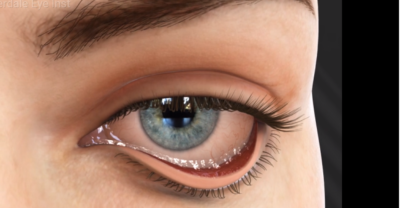Eyelids that are functioning properly will seal tightly over the eyeball when closed. Not only does this allow the eye to stay moisturized by preventing tears from drying, but it also protects it from external harm. Entropion and ectropion refer to two different eyelid abnormalities affecting the eyelid’s structure and function, namely how the eyelids move when blinking or the opening and closing of the eye. Because of the delicacy of your eyelids, any problems with their function can lead to painful symptoms and an increased risk for other infections. Age is the main factor in developing either condition, as the muscles and tissues in and around the eye deteriorate over time. Other factors include previous eye surgeries or other eye conditions.
Entropion

Entropion is when the eyelid is turned inwards toward the surface of the eye. It can occur on only one side or both, referred to as bilateral entropion. In this condition, the lower lid and eyelashes can rub against your eye, causing friction and irritation to the cornea. In addition to corneal irritation, entropion can lead to corneal abrasions, scarring, corneal thinning, and in extreme cases, corneal ulcers.
Symptoms of entropion include:
- Red eyes
- Excess tearing/watering
- Blurry vision
- Eye pain
- Eye sensitivity
- Itching
- Crusting
Treatment for entropion varies on the severity. It might include:
- Lubricating Eye Drops: This helps to lubricate the eye and relieve discomfort.
- Soft Contact Lenses: These help as a barrier to the eye’s surface, protecting your eye from further corneal abrasions and irritation. These lenses can be worn with or without a prescription.
- Taping or Stitching: An ophthalmologist can temporarily tape or stitch the eyelid to a more favorable position; however, this is not a permanent fix.
- Entropion Surgery: An oculoplastic surgeon can perform surgery to move the eyelid to a normal position in the form of eyelid tightening (shortens the lid to tighten) or retractor reinsertion (tighten the muscles that open/close your lid).
Ectropion

In contrast to entropion, ectropion is when the eyelids turn outward. This can lead to dry eye disease since the tear duct is not in a position to function properly. Additionally, the eye is further exposed to the elements such as dirt, wind, and other irritants. Ectropion is most common in the lower eyelid.
Symptoms of ectropion include:
- Excessive tearing/watering
- Excessive dryness (eyes feel gritty as if there is something in your eye)
- Light sensitivity
- Irritation
Treatment for ectropion varies on the severity. It might include:
- Lubricating Eye Drops: Lubricates the eyes to prevent further irritation
- Ectropion surgery: an oculoplastic surgeon will perform surgery on the eyelid to tighten the muscles and tendons, providing the necessary support.
During an appointment with your ophthalmologist, they will perform a thorough eyelid evaluation and determine if your symptoms are related to entropion or ectropion. From there, they can put a treatment plan into place. Don’t wait to schedule a consultation. Call our office today at 954-741-5555.






